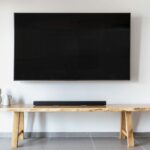How To Reduce Blooming On Your TV (A Simple Guide)
How To Reduce Blooming On Your TV (A Simple Guide)
You can reduce blooming on an LED TV by turning down the backlight setting to about half. While blooming can’t be entirely fixed, reducing the strength of the dimming setting may also help. The more local dimming zones a TV has, the better performing it’ll be at mitigating this issue.
Though different TVs have different visual capabilities, depending on their display technology, they can sometimes experience problems.
From my experience with many TVs over the years, the type of TV dictates the kinds of problems they encounter.
One of these issues that LED TVs in particular may encounter is blooming.
But what is blooming exactly, and are there ways to get rid of it or at least minimize it?
Let’s find out!
What Is Blooming?
Light bloom on a TV, which is often referred to as blooming, is when a portion of the screen that’s supposed to be dark in a particular scene, is then lit up by a nearby object or element on screen that’s brighter.
Basically the bright part will look like a visible halo around the darker part, which may then permeate into other parts of the screen.
This isn’t good since the uniformity of the image itself gets broken up.
It can be a really distracting effect if you notice it since it takes away from what the scene should actually look like.
It causes the scene to look less dynamic than it originally would have been.
Not only this, but this blooming effect can elevate black levels in specific areas.
This directly impacts image quality since that juxtaposition of light and dark that gives the image depth gets diminished.
The brighter the black levels, the less dynamic and washed out your content will look which — as you’d probably guess, obviously isn’t ideal.
That said, the degree to which it occurs depends on the individual TV since some are more prone then others.
Why Does The Issue Of Blooming On A TV Happen?
If you’re wondering why blooming happens, it’s because of the type and quality of backlight design the TV uses.
That’s because It doesn’t happen with every TV.
In fact, the only kind of TVs that blooming really affects are LCD based TVs.
The reason for that is LCD based televisions are the only ones that use some sort of backlighting to display an image.
They all implement small lights behind the screen in various ways and to varying degrees of efficacy.
This is what’s known as local dimming, meaning different parts are tasked with handling particular parts of an image.
These lights are then separated into distinct zones, and the more zones a TV has, the more intricate it can be with the picture quality it displays and its resulting black levels.
A large number of zones can help with the depth of the image.
There’s even various types of local dimming like full array local dimming and edge lit dimming which can further help picture quality.
The problem arises though when a TV doesn’t have that many zones since the light output becomes localized in brighter scenes — which results in blooming.
The more zones or lights, the less likely that it is that that particular TV will have blooming issues from what I’ve seen (though like most things it depends)
The other reason LED based TVs might experience blooming is that people might use them with backlight brightness set too high in the TV for their room.
That stems from the fact that TVs often come from the store set at the brightest setting/mode without any calibration,.
When it’s on the show floor, it has to accommodate for harsh store lighting and grab attention by being as bright as possible.
However at home this doesn’t help and while being inaccurate, it can also lead to blooming.
Here’s a few ways to optimize your TV settings for better picture quality.
https://easyhometheater.net/how-to-optimize-your-tv
The interesting thing is OLED TVS don’t rely on a backlight, and so don’t have to deal with blooming issues at all.
This results in a much more even looking picture quality.
Using an OLED display can be a good way to avoid blooming all together since they don’t have a backlight and use self lit pixels instead.
However they sometimes don’t get as bright as an LED TV would, especially with HDR content, so it’s really a tradeoff with both.
But it depends on the particular capabilities of the TV too since this isn’t always the case.
How Can You Test If Your TV Experiences Blooming?
But how do you know if your TV is experiencing blooming?
The easy way would be to play content you’re familiar with that has scenes where there’s a bright object or portion of the screen right next to a dark part of the screen — and pay attention to this area.
You can even pause it if you need to.
If you notice that the darker portion looks like it gets significantly brighter when the lighter element is introduced, then it’s likely you’re experiencing blooming.
Though this can be to varying degrees since every TV is different, and every person is different.
Some may be more sensitive to it than others, and some TVs may show the effects of it a lot more than others.
How Can You Reduce Blooming?
How exactly can you reduce blooming on your television?
Well it’s difficult to say since the issue stems from the TV itself being a backlit or edglelit LCD TV; causing parts of the screen to be incorrectly lit from the backlight.
This panel design means it’s impossible to fully get rid of since there’s still a light present.
That said, there are a few things you can do that might make it a little less perceptible like adjusting the intensity of the backlight for instance.
But keep in mind that how much of an impact or effect they’ll actually have isn’t known since every TV is different.
Turning Down The Backlight
The first, which can have an immediate effect is turning down the backlight in your settings.
Like previously mentioned, when this is set too high it can cause light bleed, and this can then lead to display issues.
Since lighting conditions will be different in every room, there really isn’t 1 best setting for this in my opinion.
However I’ve personally found that turning down your backlight to about about half and working from there is a pretty good start.
Adjusting The Strength Of The Dimming Feature
Another thing that might help with the image quality is adjusting the settings around the dimming feature if the TV has one to see what effect it might have on picture quality.
While local dimming technically can help to get a better contrast ratio, it also makes the difference between lighter and darker elements on screen greater.
In turn, this can cause blooming if the TV doesn’t have an adequate number of led zones.
So by lowering this setting you can help to mitigate this.
Though keep in mind when doing this, you might lose some dynamism in the image due to higher black levels.
Adjusting The Gamma
You could also try to adjust the gamma by making that brighter or darker too.
I’ve found that gamma has a direct impact on the TV’s picture, and that it can be used to get a more desirable result.
Though white balance and image gradation could be thrown off balance if heightened or lowered too much.
Ultimately, there’s pros and cons to each way which really highlights the overall issue.
How Can You Avoid It & Overall Takeaways
Avoiding blooming is hard since an issue that inevitably all LED TVs face due to their backlight design.
It’s just that some are much better at dealing with it than others.
I’ve noticed the more local dimming zones and better light control the TV has, the better the TV is at minimizing it.
Full array local dimming in particular works really well in that regard.
OLEDs are pretty much immune to this problem due to the fact their pixels conduct electricity and emit their own light.
Mini LED TVs and Micro LED TVs greatly minimize this issue, but they haven’t been widely adopted quite yet.
So if you find that you experience blooming, you can try the 3 methods mentioned — or even replace the TV entirely if it’s something that’s really noticeable.
Just know that with LED TVs, blooming is something that all of them will likely experience to some degree.
Now whether it’s actually noticeable though is something that’ll certainly vary.
Final Thoughts
Hopefully this offered some clarification on ways you can reduce blooming at least somewhat, since it really isn’t possible to get rid of it entirely with LCD based televisions.
That’s definitely one of a few areas where OLED TVS do have an advantage, but there’s benefits to both technologies honestly from what I’ve noticed.
With the proper display though, it’s quite possible to still enjoy that movie theater experience even while at home.
But with that, that about does it for this one.
Until next time, make it easy, keep it simple!
About Me

Jay
Hey everyone it’s nice to meet you. I'm Jay, writer & founder of the site Easy Home Theater. I've been with this hobby of home entertainment for many years now. I decided to create this site to be a helpful resource, and share everything that I've learned from personal experience with you. I also happen to be a huge gamer, lover of all things tech related, and a major fitness buff (love weightlifting)
Contact: Contact Jay
Facebook: https://www.facebook.com/Easyhometheater/
X: https://x.com/easyhometheater
Pinterest: https://www.pinterest.com/easyhometheater/pins/
Instagram: https://www.instagram.com/easyhometheater/
Followit: https://follow.it/easy-home-theater
Bluesky: https://bsky.app/profile/easyhometheater.bsky.social






Leave a Reply